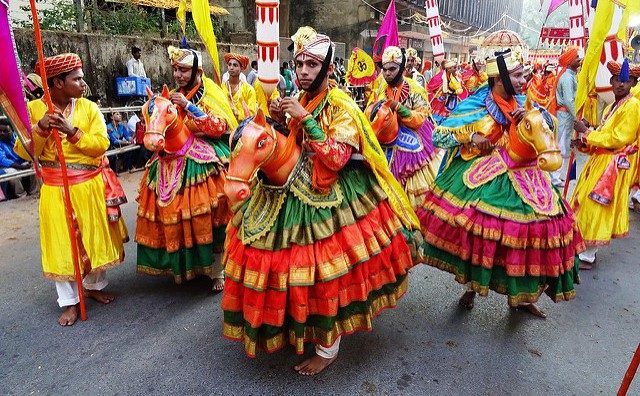Starting from the 3rd of March, Goa will see the biggest celebration of a Hindu festival spanning the next two weeks. Shigmo or Śigmō is celebrated across Goa to mark the return of men who went to war to fight against those who invaded Goa. The festival gets its name from the Prakrit word Suggimaho and the Sanskrit word Sugrishmaka. It is also known by other names such as Shishirotsava and Shigmotsav. The festival also heralds the arrival of the spring season.
Did you know that there are 2 types of Shigmotsav in Goa? You can read more here.
Shigmotsav to be celebrated all over the state
Over the next two weeks, starting from this weekend, the state will be celebrating Shigmotsav in its various towns and cities. Some say Shigmotsav is even bigger than the Carnival. This may or may not be true, however, being one of the biggest Hindu festivals, it does draw a lot of tourists to witness and be a part of all the revelry.
The parade begins with a bang when the people of Goa dress up in colorful outfits, holding multicolored flags and playing large musical instruments like the Dhol Tasha and flutes in processions across the cities.
Goan Hindu traditions and mythology are showcased in a big way throughout Shigmotsav. The streets come alive with traditional music, beats, tableaus, and floats depicting Hindu deities as well as scenes from mythology. People even dress up as characters from Hindu mythology, with their costumes being as authentic as possible. It is an extremely colorful festival and one that everyone can enjoy.
This year, with the government’s support, as is the norm, there will be parades held on different days all over the state. As mentioned before, the festival was traditionally celebrated as spring’s biggest festival. Shigmotsav also honors the homecoming of the warriors who had left their homes and families at the end of Dusshera to fight the invaders. The major highlight of these parades are the traditional folk dances and performing of mythological scenes.
Additionally, Shigmotsav depicts the Goan lifestyle through elaborate traditional folk dances. These include Ghode Modni and Fugdi being performed on the streets with massive troupes along the parade, showcasing the traditions of Goa.
Shigmotsav parades
As always, the streets of Goa are lit up with attractive décor, lively parades, delicious Goan delicacies, and music and dance performances during Shigmotsav. This year will be no different and you can be at any of the locations below on the respective dates to watch or be a part of the festivities.
The parades in all of the towns will commence at 17:00 hours.
The Shigmotsav parade schedule is as follows:
- 3rd March in Ponda (South Goa)
- 4th March in Margao (South Goa)
- 5th March in Vasco (South Goa)
- 6th March in Sanguem ( South Goa)
- 7th March in Sanquelim (North Goa)
- 8th March in Valpoi (North Goa)
- 9th March in Bicholim (North Goa)
- 10th March in Panjim (Central Goa)
- 11th March in Mapusa (North Goa)
- 12th March in Pernem (North Goa)
- 13th March in Canacona (South Goa)
- 14th March in Quepem (South Goa)
- 15th March in Curchorem (South Goa)
- 16th March in Cuncolim (South Goa)
- 17th March in Dharbandora (South Goa)
Information credit – GTDC – Shigmo Festival/ Shigmo Goa – 2018
ItsGoa/FEB/KDGP


